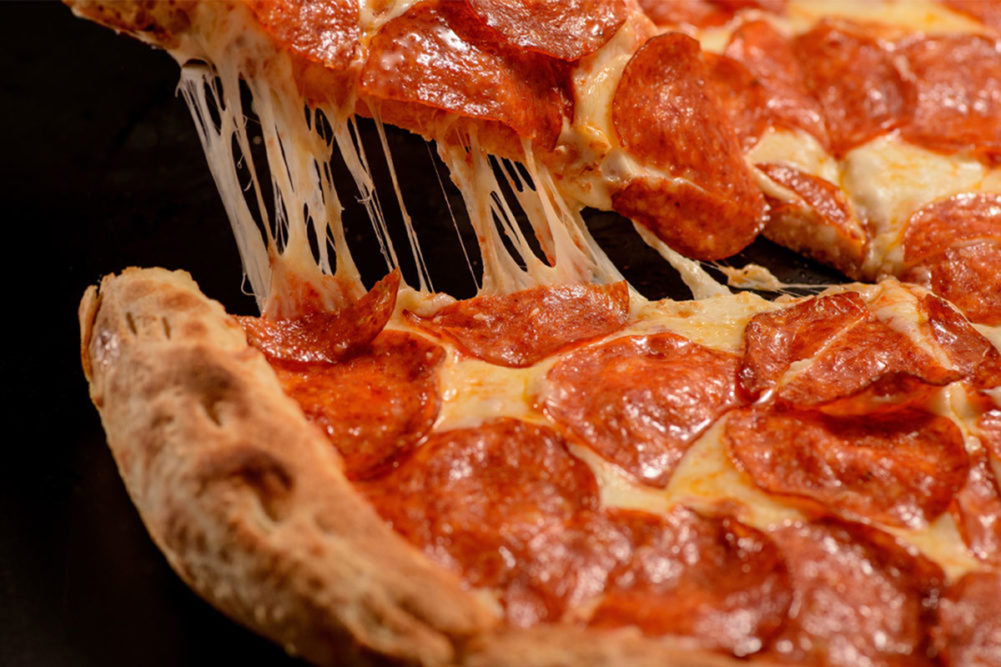At Molinaro’s Fine Italian Foods, the world of pizza is not only round, but flat and rectangular. Based in Mississauga, Ontario, the company offers 6-by-12-inch stone-baked flatbreads that come in such varieties as Buffalo Style, Bruschetta or Spinach and Cheese, to name a few, along with other custom-made toppings for private label store brands.
“The flatbreads could be used for entertaining or sliced for an appetizer, but they can also be used as a pizza for dinner,” said Joe Delduco, vice president of sales and marketing. “You just take two or three out, and they all fit in the oven at the same time.”
These flatbreads also provide more portion control than conventional pizzas.
“Most people aren’t going to eat a 12- or 14-inch round pizza, but they may buy two flatbreads because they’re smaller portions and they’re cheaper,” he said.
For in-store bakery/delis and foodservice operators, New York-based Vandemoortele USA offers everything from thick focaccia, ciabatta and pizza crusts to pinsa, a light and airy sourdough created with a biga starter, made in its bakeries in northern Italy.
“Pinsa is definitely a trend,” said Johan Coppens, master baker and culinary/technical adviser for Vandemoortele Europe NV, Ghent, Belgium, during the recent 2023 International Dairy Deli Bakery Association’s show. “I see more pinsa being made both here in America and throughout Europe, and that’s because it’s naturally delicious. It’s just water, salt, flour, olive oil and biga, instead of yeast.”
Other pizza producers are taking a crust-centric focus. Home Run Inn sells its frozen Nothing But Crust in a two-pack carton. In addition to placing menu ideas on the package, the Chicago-based company encourages consumers to create their own versions of the Windy City’s classic on its signature buttery crust.
Meanwhile, New York-based The Pizza Cupcake, which appeared on “Shark Tank” a few years ago, is expanding nationally with cupcake-shaped items that come in margherita and pepperoni flavors and in a brioche-style dough.
Such creativity is needed to elevate the experience and drive sales in this category.
“There’s room to enhance retail pizza’s image both as an indulgent treat and as a healthy meal option,” noted John Owen, associate director, food and retail, Mintel, in its 2022 pizza report. “Innovation in both these directions will help the category attract more users and capture new-use occasions.”
With persistent inflation, budget-conscious consumers are searching for more frozen pizza options.
“We are seeing consumers trading out of restaurant pizza and into premium frozen pizza,” said Maddie Essman, senior marketing manager for Schwan’s Consumer Brands Inc., Bloomington, Minn. “These consumers can still get a great pizza but at a fraction of the price by switching over.”
She also noticed an increase in value pizza consumption to reduce grocery expenses.
“Consumers can purchase a Red Baron pizza for around $5 and a Tony’s pizza for around $4,” Ms. Essman said. “These options present affordable and delicious pizzas that the entire family can enjoy.”
Mintel noted that nearly three quarters of those surveyed reported that their household has eaten pizza from a supermarket in the past three months.
But here are two key observations to consider. More than three quarters of retail pizza consumers agree that delivery pizza tastes better. Mintel stated this suggests that delivery remains the standard for judging retail pizza quality.
Secondly, the report pointed out that nearly half of retail pizza consumers said they would like to see more refrigerated and frozen pizza with extra toppings, indicating that some consider retail pizza could be “skimpy” on toppings.
Mintel mentioned products that promise and deliver extra cheese or toppings are likely to have a more receptive audience. Perhaps that’s why many brands offer “loaded” or extra toppings options.
Unpredictable ingredient costs, however, make value-added a tricky proposition.
“We have to find ways to defray additional price increases because we’re going to price ourselves out of consumers’ pocketbooks if we keep increasing double digits, so the way to do that is through penetration, buy rate and frequency,” observed Sally Lyons Wyatt, executive vice president and practice leader for client insights at Circana. “We need to find a way to get into new homes and/or to get the households that are purchasing pizza to buy it more often or buy more when they purchase it. That may require buy-one-get-one or buy-three-get-one promotions, or another type of promotion to drive incremental units.”
Ms. Essman pointed out the peak seasons for frozen pizza bookend the year.
“Each calendar year starts strong as large sporting events in football and basketball create moments where consumers look to frozen pizza to feed their families and friends,” she explained. “As students return to school in late summer or early fall, families look to frozen pizza as a delicious, convenient option. This uptick in consumption continues through [the fourth quarter] as frozen pizza consumers look for options to cut down on meal prep and have crowd-pleasing options as they gather with their loved ones during the holidays.”
In such a competitive market, Mr. Delduco said the private label segment needs to differentiate itself.
“The challenge is that national brands are acting like private label brands,” he said. “These national brands are on promotion 70% to 80% of the time so you can get a national branded pizza anytime on sale.”
He added slightly smaller sizes, such as a 10-inch pizza, provide about the same net weight as a 12-inch variety and allow retailers to charge a more affordable, everyday low price.
Moreover, Molinaro’s now offers a Neapolitan crust that’s fluffier and softer than what’s in the market as well as spicy Tandoori, Korean BBQ and other niche varieties that cater to regional preferences.
“We like to say, ‘We’re not here to duplicate anything. We’re here to fill that void,’ but the customer needs to tell us what that void is,” Mr. Delduco said.

